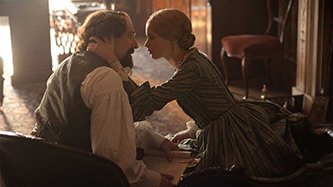The Invisible Woman is a proof of how an established actor can make interesting choices when stepping behind the camera. The first choice? To star in the production, as well as direct it (though you’re probably getting the hang of it after directing yourself in last year’s Coriolanus). I can see why you wanted the role: Charles Dickens is a complex character, and your portrayal of him allows you to explore his highly dualistic nature.
The second choice is your focus on restraint. The premise of a young, working woman being kept as a mistress by an older distinguished man, although interesting, wouldn’t be half as tense without such space between the two. The affair between the young woman, Nelly, and Dickens feels chaste, yet it’s filled with tension because Nelly isn’t invisible at all—the least of all to Dickens. And that’s the beauty of their relationship. It’s dangerous. Dickens sees her so often – as do his wife and friends – that his intentions become blatantly obvious to everyone around him. Dickens thinks he can keep Nelly hidden in plain sight, but even by that era’s standards of propriety it’s an impossible feat.
It doesn’t help the situation when Dickens turns around and basically ditches his wife by writing an open letter about the breakdown of his marriage. Ouch. Any woman would feel a little sore. But he’s Charles Dickens. He has a flair for the dramatic. And the way that you portray him makes it clear that he’s less interested in recapturing his youth than he is in simply being adored by an intelligent, beautiful, vibrant woman. The daily grind of marriage with a woman who’s birthed ten of your children, and, as portrayed in your film, not so wise in the way of words—well, I can’t imagine it would have been all that stimulating for a man of such virility.
As the film unfolds, The Invisible Woman moves at a steady pace between Nelly’s memory of her life after meeting Dickens and the present reality of her new life with husband and child. Your inclination as a director is to alternate big sweeping expanses with subtle emotional details. But it’s when you let those emotional details recede into the fabric of the frame that the film becomes truly breathtaking. Nelly is free and restrained at the same time, and it’s her determination to break free that keeps the story moving and alive in the present.
The way the handheld camera is unsettled around Dickens mimics his manic energy. Blurring the background seems to be an intentional choice, conjuring the mood of Impressionist painters like Monet, Renoir, and Degas. I don’t know many movies in which such a choice stands out so prominently—or works so well. It feels chaotic at first, but once the restraint of the relationship takes hold, the tone is appropriate, somehow loose and tightly-held at the same time.
There is a definite duality at play here. Both in the way the film is directed and in your acting choices: goodness and cruelty, light and dark, freedom and restraint. The Invisible Woman has a lot more going on than one might think. And so did Dickens, apparently.
Well done.
Signed,
Jennifer







